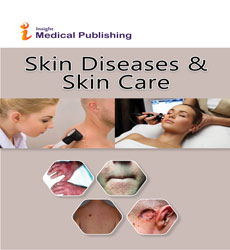Psychological Impact of Pigmentation Disorders
Hongkai Chen
Department of Dermatology, The Warren Alpert Medical School of Brown University, Providence, USA
Published Date: 2024-03-17DOI10.36648/ipsdsc.9.1.117
Hongkai Chen*
Department of Dermatology, The Warren Alpert Medical School of Brown University, Providence, USA
- *Corresponding Author:
- Hongkai Chen
Department of Dermatology,
The Warren Alpert Medical School of Brown University, Providence,
USA,
Email: Huang_p@ubc.ca
Received date: February 19, 2024, Manuscript No. IPSDSC-24-18968; Editor assigned date: February 22, 2024, PreQC No. IPSDSC-24-18968 (PQ); Reviewed date: March 07, 2024, QC No. IPSDSC-24-18968; Revised date: March 14, 2024, Manuscript No. IPSDSC-24-18968 (R); Published date: March 21, 2024, DOI: 10.36648/ipsdsc.9.1.117
Citation: Chen H (2024) Psychological Impact of Pigmentation Disorders. Skin Dis Skin Care Vol.9 No.1: 117.
Description
Pigmentation disorders, also known as dyschromias, encompass a wide range of conditions that affect the color of the skin, hair, or eyes. These disorders can manifest as patches of lighter or darker skin, or alterations in the color of the hair or eyes. While many pigmentation disorders are harmless, some may cause significant cosmetic concerns or even health issues. Understanding the causes, symptoms, and available treatments for pigmentation disorders is crucial for proper management and care.
One of the most common pigmentation disorders is hyperpigmentation, characterized by areas of the skin becoming darker than the surrounding skin. This can occur due to an overproduction of melanin, the pigment responsible for skin coloration. Sun exposure, hormonal changes (such as pregnancy or hormonal therapy), inflammation, and certain medications are common triggers for hyperpigmentation. Conditions such as melasma, post-inflammatory hyperpigmentation, and age spots are all forms of hyperpigmentation.
Pigmentation disorders
Conversely, hypopigmentation involves areas of the skin that are lighter than the surrounding skin due to a decrease in melanin production. Vitiligo is one of the most well-known hypopigmentation disorders, characterized by the development of white patches on the skin. While the exact cause of vitiligo is not fully understood, it is believed to involve autoimmune factors that lead to the destruction of melanocytes, the cells responsible for producing melanin. Other causes of hypopigmentation include genetic factors, certain infections, and inflammatory skin conditions. Albinism is another pigmentary disorder characterized by a complete or partial absence of melanin in the skin, hair, and eyes. Individuals with albinism typically have very pale skin, white or light-colored hair, and light-colored eyes due to the lack of pigment production. Albinism is a genetic condition caused by mutations in genes involved in melanin production.
While many pigmentation disorders primarily affect the skin, some can also involve changes in hair or eye color. For example, poliosis is a condition characterized by the development of patches of white hair due to a lack of melanin in the hair follicles. Similarly, heterochromia iridum refers to a difference in coloration between the iris of the two eyes, which can occur due to genetic factors or as a result of injury or disease. The impact of pigmentation disorders extends beyond cosmetic concerns, as they can also have psychological and emotional effects on individuals. Conditions such as vitiligo and albinism may lead to social stigma, low self-esteem, and feelings of selfconsciousness, particularly in societies where fair skin is highly valued. Therefore, providing support and education to individuals affected by pigmentation disorders is essential for promoting acceptance and understanding.
Treatment options for pigmentation disorders vary depending on the underlying cause and severity of the condition. In cases of hyperpigmentation, topical treatments such as hydroquinone, retinoids, corticosteroids, and chemical peels may help to lighten the affected areas. Laser therapy is also a common approach for targeting and reducing excess pigment in the skin. For hypopigmentation disorders like vitiligo, treatment options aim to either restore pigment or depigment the remaining skin to achieve a more uniform appearance. Phototherapy, topical corticosteroids, and topical calcineurin inhibitors are commonly used to stimulate repigmentation in vitiligo patches. In cases where widespread depigmentation has occurred, treatments such as monobenzone cream may be used to lighten the remaining skin to match the depigmented areas. While treatment options for pigmentation disorders have advanced significantly in recent years, management can still be challenging, and complete resolution may not always be possible. Additionally, ongoing research into the underlying causes of pigmentation disorders is essential for developing more effective therapies and improving outcomes for affected individuals.
In conclusion, pigmentation disorders encompass a diverse group of conditions that affect the coloration of the skin, hair, and eyes. From hyperpigmentation to hypopigmentation and conditions like vitiligo and albinism, these disorders can have significant physical, emotional, and psychological effects on individuals. Understanding the causes, symptoms, and available treatments for pigmentation disorders is crucial for providing comprehensive care and support to those affected by these conditions.
Open Access Journals
- Aquaculture & Veterinary Science
- Chemistry & Chemical Sciences
- Clinical Sciences
- Engineering
- General Science
- Genetics & Molecular Biology
- Health Care & Nursing
- Immunology & Microbiology
- Materials Science
- Mathematics & Physics
- Medical Sciences
- Neurology & Psychiatry
- Oncology & Cancer Science
- Pharmaceutical Sciences
